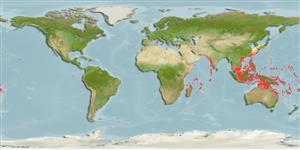Echinoidea |
Camarodonta |
Toxopneustidae
Environment: milieu / climate zone / εύρος βάθους / distribution range
Οικολογία
Υφαλόφιλο(α); εύρος βάθους 0 - 90 m (Αναφ. 81020). Tropical
Southeast Atlantic and Indo-West Pacific.
Length at first maturity / Μέγεθος / Weight / Age
Γεννητική Ωρίμανση: Lm ? range ? - ? cm Max length : 15.0 cm WD αρσενικό/απροσδιόριστο; (Αναφ. 800)
Inhabits coral rubble and rocky reef areas, seagrass beds and coral reefs (Ref. 800). Has poisonous pedicellariae (Ref. 2957). Feeds on calcareous sediments (Ref. 108108). Found in waters less than 30m. Dwells on soft substrates. Feeds on encrusting coralline algae and turf algae (Ref. 129602).
Life cycle and mating behavior
Γεννητική Ωρίμανση | Αναπαραγωγή | Γεννοβολία | Eggs | Γονιμότητα | Larvae
Members of the class Echinoidea are gonochoric. Fertilization is external. Brooding is common, eggs are held either on the peristome, around the periproct or deep into the concavities on the petaloids. Life cycle: Embryos develop into planktotrophic larvae (echinoplateus) and live for several months before they sink to the bottom using their tube feet to adhere on the ground where they metamorphose into young urchins.
Schoppe, S. 2000 A guide to common shallow water sea stars, brittle stars, sea urchins, sea cucumbers and feather stars (echinoderms) of the Philippines. Times Media Private Limited, Singapore. 144 p. (Αναφ. 800)
IUCN Red List Status
(Αναφ. 130435: Version 2025-1)
CITES status (Αναφ. 108899)
Not Evaluated
Not Evaluated
Threat to humans
Human uses
αλιεία: Εμπορικό(ά)
| FishSource | Η θάλασσα γύρω μας
Εργαλεία
Περισσότερες πληροφορίες
Population dynamicsΑύξηση
Max. ages / sizes
Length-weight rel.
Length-length rel.
Length-frequencies
Mass conversion
Αφθονία
Life cycleΑναπαραγωγήΓεννητική ΩρίμανσηΓονιμότηταΓεννοβολίαEggsEgg developmentLarvae PhysiologyΚατανάλωση οξυγόνου
Human RelatedStamps, coins, misc.
Διαδικτυακές πηγές
Estimates based on models
Preferred temperature
(Ref.
115969): 24.6 - 29, mean 28 (based on 1174 cells).
Fishing Vulnerability
Low vulnerability (10 of 100).
Price category
Unknown.
Nutrients : Calcium = 126 [75, 177] mg/100g; Iron = 5.08 [1.67, 7.92] mg/100g; Protein = 12%; Omega3 = 0.331 [0.263, 0.400] g/100g; Selenium = 0.04 [48.48, 67.17] μg/100g; VitaminA = 0 μg/100g; Zinc = 1.97 [0.92, 3.02] mg/100g (wet weight); based on
nutrient studies.
